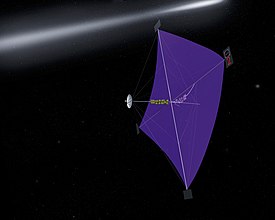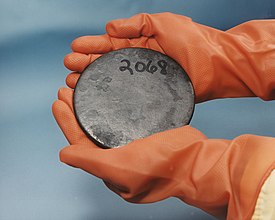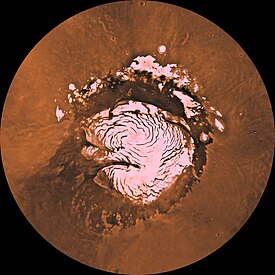Portal:Physics/2008 Selected articles
This is an archive of entries that have appeared or will appear onPortal:Physics'sSelected Articlesection in 2007. Articles for previous weeks should not be edited.
Please do not edit this page directly.Instead, use one of the "Edit selected article" links on the right of this page. This will ensure that you edit the correct page for your changes to appear onPortal:Physicsin the correct week.
January
[edit]
|
| Schematic of aneutron |
Inphysics,theneutronis abaryonthat consists of two downquarksand one upquark.Itsstrong forceradiation is the primary force that holdsatomic nuclei.It also has amassof 1.008 664 915 (78) u (1.6749 × 10−27kg (939.573MeV/c²), but noelectric charge.Neutrons additionally radiatebeta decayand have aspinof ½. Neutrons are present in the majority of nuclei, however in aweighted majoritythey are not. The number of neutrons in a nucleus determines theisotopeof the atom. For example,protium,or1H, is an isotope of Hydrogen with no neutrons, whiledeuterium,or2H, contains one. Neutrons were discovered in1932byPhysicistJames Chadwicktwo years after they were unexplainably detected byPhysicistWalther Bothe.
February
[edit]Erwin Schrödinger(German pronunciation:[ˈɛrviːnˈʃrøːdɪŋɐ];August 12, 1887 – January 4, 1961) was anAustrian-Irishphysicistwho achieved fame for his contributions toquantum mechanics.In 1935, after correspondence withAlbert Einstein,he proposed theSchrödinger's catthought experiment.In1933,Schrödinger was awarded the Nobel Prize in Physics, along with physicistPaul Diracfor "the discovery of new productive forms ofatomic theory"in regard to theSchrödinger equationwhich he proposed in1926.One of Schrödinger's lesser-known areas of scientific contribution was his study ofcolor,color perception,and the field ofcolorimetry
March
[edit]Aplanetary nebulais anastronomical objectconsisting of a glowing shell ofgasandplasmaformed by certain types ofstarsat the end of their lives. The name originates from a similarity in appearance togiant planetswhen viewed through a small optical telescope, and is unrelated toplanetsof the solar system. They are a relatively short-lived phenomenon, lasting a few tens of thousands of years, compared to a typical stellar lifetime of several billion years.
In recent years,Hubble Space Telescopeimages have revealed many planetary nebulae to have extremely complex and varied morphologies. About a fifth are roughlyspherical,but the majority are not spherically symmetric. Their formation depends on the mass of its star; lower mass stars, such as thesunusually form planetary nebulae, while higher mass stars, such asZeta Ophiuchiwill not. The average nebula is approximately 1light yearacross.
April
[edit]
Microwavesareelectromagnetic waveswithwavelengthsbetween one meter and one millimeter, or withfrequenciesbetween 300megahertzand 300 gigahertz.
Apparatuses and techniques may be described qualitatively as "microwave" when the wavelengths of signals are roughly the same as the dimensions of the equipment, so thatlumped-element circuit theoryis inaccurate. As a consequence, devices that utilize microwaves, such as the microwave communications tower pictured, tend to move away from the discreteresistors,capacitors,andinductorsused with lower frequencyradio waves.Open-wire and coaxialtransmission linesgive way towaveguides,and lumped-element tuned circuits are replaced by cavityresonatorsor resonant lines. Similarly to visible light, the phenomena ofreflection,polarization,scattering,diffraction,and atmosphericabsorptionare observed in microwaves.
Microwaves were first theorized in1864byJames Clerk Maxwell,and were later detected in the1940sbySir John RandallandDr Harry Boot.Since then, microwaves have been used in communication, remote sensing of both earth based and astronomical bodies, food preparation, and non lethal weaponry.
May
[edit]
The Speed of Light,orc,is a physical constant equal to exactly 299,792,458meters per second,or approximately 983,571,056feet per second,and is the speed of all frequencies of light in a vacuum. Since 1983, the speed of light is used to define theSIunit if onemeter.Light can travel at average lower speeds when passing through translucent materials. Denser materials than air, slow the observed speed of light down more than lighter ones do. For instance, light traveling through a diamond travels at approximately 124,000,000 meters per second.
Experimental evidence has shown that the speed of light is independent of the motion of the source. It has also been confirmed experimentally that the two-way speed of light (for example from a source, to a mirror, and back again) is constant. It is not, however, possible to measure the one-way speed of light (for example from a source to a distant detector) without some convention as to how clocks at the source and receiver should be synchronized. Einstein postulated that the speed of light should be taken as constant in all cases, one-way and two-way.
Astronomicaldistances are sometimes measured inlight years(the distance that light would travel in one Earth year, roughly9.46×1012kilometres or about 5.88×1012miles). Because light travels at a large but finite speed, it takes time for light to cover large distances. Thus, the light we observe from distant objects in the universe was emitted from them long ago (pictured is theCrab Nebulaas it looked ~6.5 X 103years ago).
June
[edit]
Spacecraft propulsionis any method used to change the velocity ofspacecraftand artificialsatellites.Most spacecraft today are propelled by expelling a gas from the rear of the vehicle at very high speed through arocket engine nozzle.Most current spacecraft use chemical rockets (bipropellantorsolid-fuel) for launch (some, suchSpaceShipOne,used jet engines in their first stage). Most satellites have simple reliable chemical thrusters (oftenmonopropellant rockets) orresistojet rocketsfororbital station-keepingand some usemomentum wheelsforattitude control.Soviet bloc satellites have usedelectric propulsionfor decades, and newer Western geo-orbiting spacecraft are starting to use them for north-south stationkeeping. Interplanetary vehicles mostly use chemical rockets as well, although a few have experimentally usedion thrusters.Spacecraft propulsion systems are often first statically tested on the Earth's surface, within the atmosphere but many systems require a vacuum chamber be accurately tested.
July
[edit]
Uraniumis a silver-graymetallicchemical elementin theactinideseries of theperiodic tablethat has thesymbolUandatomic number92. It has 92protonsandelectrons,6 of themvalence electrons.Uranium has the highest atomic weight of the naturally occurring elements. It occurs naturally in low concentrations (a fewparts per million) in soil, rock and water, and is commercially extracted from uranium-bearingmineralssuch asuraninite.There are many current applications of uranium, including the fissile explosive material used innuclear weapons,fuel fornuclear power plants,high density bullets, and, prior to the discovery of the harmful effects of its radiation, glass and ceramic dyes, and in luminescent paints...
August
[edit]
Mars/ˈmɑːrz/is the fourthplanetfrom theSunin theSolar System.The planet is named afterMars,theRomangod of war.It is also referred to as the "Red Planet" because of itsreddish appearance.Mars has two tiny natural moons,PhobosandDeimos,discovered in 1877 byAsaph Hall,which orbit very close to the planet and are thought to be captured asteroids.
Mars is aterrestrial planetwith a thinatmosphere,having surface features reminiscent both of theimpact cratersof theMoonand thevolcanoes,valleys,desertsandpolar ice capsof Earth. It is the site ofOlympus Mons,the highest knownmountainin the Solar System, and ofValles Marineris,the largest canyon. Mars has been the focus of dozens of missions, the most recent being theMars Scout Program'sPhoenixprobe...
September
[edit]
Awhite dwarf,also called adegenerate dwarf,is a smallstarcomposed mostly ofelectron-degenerate matter.As white dwarfs have mass comparable to theSun's and their volume is comparable to theEarth's, they are verydense.Their faintluminositycomes from the emission of storedheat.They comprise roughly 6% of all known stars in the solar neighborhood The unusual faintness of white dwarfs was first recognized in 1910 byHenry Norris Russell,Edward Charles PickeringandWilliamina Fleming,and the namewhite dwarfwas coined byWillem Luytenin 1922. White dwarves continue to lose energy and fade, becomingBlack dwarfs...
